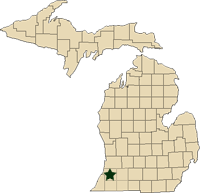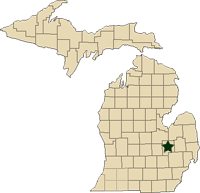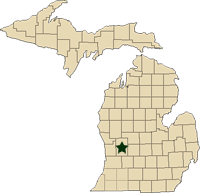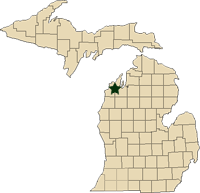Regional reports on Michigan fruit – August 7, 2012
MSU Extension educators’ pest and fruit updates for Michigan.
This week’s regional reports:
- Southwest Michigan - Mark Longstroth, Bill Shane, Diane Brown
- Southeast Michigan - Bob Tritten
- Grand Rapids Area Tree Fruit - Amy Irish Brown and Phil Schwallier
- Northwest Michigan - Nikki Rothwell and Duke Elsner
Southwest Michigan – Mark Longstroth, Bill Shane, Diane Brown, Michigan State University Extension
|
Weather
Temperatures moderated somewhat last week with highs in the upper 80s and lower 90s. Scattered rainfall over the last week provided some areas with relief from drought by recharging the topsoil with water. Some areas received over an inch, others less than a tenth of an inch. Cooler temperatures are forecast for the coming week. Our growing degree day accumulations continue two or more weeks ahead of normal.
|
Southwest Michigan Growing Degree Day Totals from January 1 through August 6 | |||
|
Location |
GDD 42 |
GDD 45 |
GDD 50 |
|
3320 |
2904 |
2272 | |
|
3202 |
2789 |
2163 | |
Be sure and check the MSU Extension Fruit page at the new MSU Extension site for more information.
Small fruit
Japanese beetle activity increased after recent rains, but we expect it to wind down shortly. Spotted winged Drosophila (SWD) has increased and we expect more this coming week with cooler temperatures. We can expect a new generation every two or three weeks. This pest has been found in all ripening small fruit except grapes, which are not yet ripe.
Strawberry growth is good where growers have irrigated. Potato leafhopper burn can be seen in some plantings. Day neutral strawberries in the high tunnels have slowed down. Powdery mildew is present on some experimental varieties. Two-spotted spider mites are present in moderate numbers. SWD flies have been found in the high tunnel strawberry plantings at Southwest Michigan Research and Extension Center (SWMREC) and larvae have been recovered from the fruit.
In brambles, blackberry harvest continues and fall raspberry harvest is underway. We continue to see sunscald on blackberries in field plantings. This is caused by high temperatures and intense afternoon sunlight. Raspberry primocanes are growing well with the increased rainfall. Growers report spider mites, Japanese beetles and potato leafhoppers. Spider mites and spotted wing Drosophila are the primary problems in high tunnel raspberries.
Spotted wing Drosophila females and males have been trapped in high tunnel blackberry and raspberry plantings at SWMREC, and larvae have been found in the fruit. We continue to see redberry mite damage on blackberries and similar injury on fall red raspberries in the tunnels. This is characterized by uneven ripening of drupelets, with some turning black and others remaining red. The raspberries show uneven ripening with some druplets remaining white.
Blueberry harvest is winding down rapidly and we are close to the end of the season. Growers are machine-harvesting Elliott. Spotted winged Drosophila (SWD) numbers are up. Blueberry maggot emergence is up following last week’s rain. Growers with ripening fruit should be controlling these pests. See the Blueberry Insect Scouting Report for July 29-August 4, 2012 for more information. Controls foranthracnose and Alternaria fruit rots should be maintained.
In Grapes, primaries of ‘Concord’ are at veraison, but secondaries are not yet showing color. Wine grapes are at bunch closure and some are showing color. Japanese beetle feeding is declining. We are now well into the third generation of grape berry moth. Fourth generation grape berry moth is likely near the end of August. We are currently at 1,926 GDD base 47 at the Bainbridge Enviro-weather station (biofix date May 21) and 2,072 GDD base 47 at the Berrien Springs Enviro-weather station (biofix date May 19). Check the grape berry moth model at the MSU Enviro-weather website to check the progress of the model for your vineyard. Grape berry moth trap catches varied last week, with most infested clusters found along borders.
Grape disease pressure continues to be low. Recent rainfall may increase humidity, providing more favorable conditions for powdery mildew. We found powdery mildew on some clusters of ‘Gewürztraminer’ near an end post where they may have been missed by a fungicide application. Downy mildew may become a problem when we get daily, heavy dews in August.
Tree fruit
With the recent rain, foliage is greening up and showing better color. Buds that had set have resumed growth. Crawlers of the second generation of San Jose scale started emerging three weeks ago. Rain has reduced some of the stress caused by European and two-spotted mites.
Peaches are showing leaves with yellow stippling due to two-spotted spider mite feeding. Yellowing and drop of older leaves is common in sandy sites from a combination of stresses. Varieties ripening now include Loring, Canadian Harmony, PF17 and some Allstar. Cladosporium scab symptoms (greenish-brown clustered spots) are showing up on fruit with minimal spray programs. The hot weather has caused some varieties to ripen on the outside of fruit earlier than the inside.
Flavor of peaches continue to be generally very good. Oriental fruit moth trap catches continue to be relatively light for the fifth week of the second generation. Infested fruit can be found in unsprayed orchards.
Cherry orchards are dry and cherry leaf spot is not a serious problem in either sweet or tart cherries. Post-harvest pruning of mature trees is probably not a good idea where trees are drought-stressed.
Plum tree decline is being seen due to a combination of drought stress and miscellaneous trunk problems. Trees are resuming foliage growth.
In apples, Paula Red and Zestar are being spot-picked for ripe fruit. Trees with dogwood borer damage to the graft union regions have been declining due to recent heat and drought putting additional stress on trees. Due to the early warm temperatures, predicted harvest dates for apples are up to three weeks ahead of normal. Pressure-testing and starch tests will be important to help determine when the apples are actually approaching maturity. Gala normally harvests earlier during seasons with relatively high temperatures.
The light apple crop will make harvest go quickly, but the hot weather will increase the tendency of fruit to drop quickly. NAA is generally applied as a stop-drop material when fruit start to drop, about two weeks or less before harvest, but not less than four days. The stop-drop chemical Retain is applied at least 28 days before harvest, but not earlier than 35 days.
Codling moth second generation flight continues to decline. Reports of obliquebanded leafroller feeding in foliage are generally uncommon. Oriental fruit moth second generation moth flight is continuing at a low level – fruit entries by the larvae can be found. Leaf bronzing from European red mites, two-spotted spider mites and rust mites is common. Apple maggot fly catch has increased with recent rainfall.
Pear fruit are about 2.75 inches or more in diameter on Harrow Sweet. Rolled leaves due to drought stress are being seen in orchards on sandy sites. Pear psylla is present in low numbers.
Meetings
The final in-season grape meeting is scheduled for August 14 from 6 to 8:30 p.m. at Bob Dongvillo’s vineyard, 4930 Niles Rd., St. Joseph, Mich. (view map). The meeting cost is $15 and includes supper and 2 RUP credits. Please help us get keep meeting costs down by registering and paying in advance. The registration form should be mailed to Jamie at the Berrien County MSU Extension office, 1737 Hillandale Rd., Benton Harbor, MI 49022.
MSU’s Rufus Isaacs will be providing information about grape berry moth and other insects of interest as we get closer to harvest. MSU’s Annemiek Schilder will give an update on grape disease development, and MSU’s Eric Hanson will provide information about grape nutrition and foliar testing.
A hop production workshop will be held at SWMREC August 21 from 9 a.m. to 3 p.m.
Southeast Michigan – Bob Tritten, Michigan State University Extension
|
Weather
Drought conditions returned to the region after a short respite that came with rains on July 26-27. Wilting tree and small fruits started to show some sign of rebounding, and even the sod in orchard row middles started to green up as a result of this rain.
Hot weather over the weekend and windy conditions earlier this week have taken all of the moisture from these rain events. Drought stress is most prevalent on peaches, sweet and tart cherries, newly planted and young apple trees, renovated strawberries and fall red raspberries. Signs of drought stress are evident in native trees in fence rows and understory trees in woodlots. Drought stress has also resulted in reduced fruit size in blueberries, resulting in an early end to harvest at some farms and collapse of fruiting terminals in fall red raspberries at other farms.
In tracking the precipitation totals from the seven Enviro-weather stations I report growing degree day totals on across the region, we are averaging a 5-inch shortfall of precipitation for the season that started on March 1. The exceptional heat of this season has also added to our drought conditions.
Our early warm season is still running nearly three weeks ahead of normal in terms of growth stages, and with all of the heat this season we are back to being more than three weeks ahead of normal in terms of degree day totals.
|
East Michigan Growing Degree Day Totals for March 1 to August 6 | |||
|
Location |
GDD42 |
GDD45 |
GDD50 |
|
Commerce (Oakland) |
3098 |
2702 |
2087 |
|
Emmett (St Clair) |
3047 |
2657 |
2051 |
|
Flint (Genesee) |
3094 |
2692 |
2080 |
|
Lapeer (Lapeer) |
3080 |
2688 |
2078 |
|
Petersburg (Monroe) |
3250 |
2846 |
2219 |
|
Pigeon (Huron) |
2914 |
2528 |
1936 |
|
Romeo (Macomb) |
3150 |
2753 |
2134 |
Tree fruits
Apple harvest of Paula Reds began early this week and Ginger Gold and Zestar harvest is expected toward the end of the week. Many apple varieties are approaching 3 inches in diameter. This is surprising to me with the lack of soil moisture for much of our growing season. On the other hand, the few growers with an apple crop this season have just over half to three-quarters of a crop. So with fewer fruit on the tree, apple size is going to be better.
Apple maggot trap catch continues in fairly high numbers, with all of the catch still on yellow sticky traps and none this season on red sphere traps. Potato leafhopper leaf curling continues to be very common in unsprayed blocks. Codling moth trap catch has remained very low and steady the last five weeks.
Overall, we had very high numbers of codling moths caught on traps for the first generation flight this season and no flight for the second generation yet. This is puzzling to me as to why no trap catches yet for second generation flight. Where growers have an apple crop this season, the second generation adult flight will need to be closely monitored and controlled.
Japanese beetle numbers have dropped in the last week. European red mite and two-spotted spider mite populations are being kept in check by predators at most farms where there is no crop, however I am seeing some bronzing of leaves in a few trees where growers are controlling pests this season.
Powdery mildew-infected terminal branches continue to die back in unsprayed apple blocks. A few strikes of fire blight continue to be seen, and I continue to see a few larger branches die due to black rot infection in the wood.
I have been asked by a good number of apple growers who do not have a crop this season why apple scab isn’t more prevalent in their apples this year. Most of these farms stopped apple scab controls shortly after the April 29 freeze event. The answer to this question is related to the lack of infection periods shortly after this freeze event; in other words, to our dry season. Keep an eye on crabapples that are affected by this same disease. Most of their leaves have yellowed and dropped to the ground as a result of early season infections of apple scab. Thus, those early season scab sprays did a great deal of good.
Pear leaves are starting to yellow from drought stress and are dropping to the orchard floor. Suckers need to be removed to help reduce pear psylla populations.
Peach harvest of Red Haven has ended and growers are finishing up harvest on the next set of varieties. I have had a number of reports of peaches ripening faster on the outside of the peach than on the inside of the fruit; this is a result of hot weather. Fruit size is being reduced from drought stress at most farms.
Sweet cherry and tart cherry leaf drop from a combination of drought stress and cherry leaf spot disease continues.
Plums look tough this season as a result of no crop at most farms and the lack of pest controls, and lately from drought stress.
Small fruits
Strawberry fields that have not had irrigation applied since renovation continue to look tough over the last four weeks, mainly due to drought stress. I am concerned that many of these fields might not recover. Even where irrigation has been applied, fields are not rebounding as they typically do from the stress of renovation this dry season. Where potato leafhopper controls have been applied in new berries this year, plantings look much better with a great deal of runnering taking place, with most rows now filling out.
Raspberry harvest on fall bearing types from fruiting lateral canes or bud berries started at most farms a few weeks ago. This harvest is rather limited, however, and most farms are not able to open consistently. Many growers had thought that since so many of our other fruit crops began harvest two weeks early (e.g., strawberries and blueberries) this season that fall raspberries would be early as well. This is not the case for fall raspberries. Remember that fall red raspberries were mostly burned back to the ground from the April 29 freeze event, thus they started from scratch again at that time, making the beginning of harvest about the same date as most years.
Tips of some canes of fall raspberries have dried up due to drought stress. Leaf drop of the lower leaves from drought stress is extensive in fall bearing varieties at most farms. Lastly, most growers report that canes 1 to 1.5 feet shorter this season. This, too, is related to drought stress. Even where raspberries have been irrigated regularly this season, I am seeing many of these signs of drought stress. There is nothing like the rain that Mother Nature provides! Unless the drought ends soon, I am fearful that growers may not be able to harvest even half of their normal yield.
Spotted wing Drosophila trap catches started to be seen four weeks ago at just a few farms that had trap catches last year. We are finding that trap catches decline a bit in hot weather, however it will increase again when cooler temperatures resume. I had expected to see more widespread trap catches in the last few weeks.
Blueberry harvest will be wrapping up in the next week or so at many farms as berry size is diminished due to drought stress at many farms. Blueberry maggot trap catch continues at most farms, especially where there has been a good rain event. Japanese beetle numbers have declined sharply in the last week. Remember to check spotted wing Drosophila traps. Bird feeding is extensive at most farms.
Grape berry size is extremely variable this season due to freeze damage that killed most of the primary flower buds.
Grand Rapids Area Tree Fruit– Amy Irish Brown and Phil Schwallier, Michigan State University Extension
|
Crop update
Soil conditions on the Ridge are adequate and everything has greened up considerably with the rains of a week ago. Growing degree days (GDD) are running ahead of normal averages by 23 to 29 days.
A few growers tell me that they might be harvesting Paula Reds and Gingergolds on the Ridge any day now and in the Hart/Shelby area by the weekend. The weather forecast for this week will bring some much needed cooler nights that will help with color development on Paula Reds and other varieties.
For those with viable apples, we are in the window for Retain applications for several early varieties. Retain is applied at its earliest about 30 days before anticipated harvest, but there are many ways you can use Retain to fit your own harvest plan – even in an early year like this one.
Fire blight update
The risk continues this year in blocks that have active blight and continued growth of shoots. Just be watchful for weather that rips or tears foliage.
Brown rot in peaches
For those few valuable peaches out there, be sure to keep them covered for brown rot.
Tree fruit pests
Obliquebanded leafrollers. Small larvae are being reported in apple blocks and cover sprays are important where you have fruit to protect.
Codling moth trap numbers of adult males have continued to be high in many blocks, but they do seem to have reached a peak and are now lessening. We have accumulated 1,782 GDD50 since the May 3 biofix on the Ridge, indicating that second generation egg laying is at or just past a peak level. Egg hatch is estimated to be at 75 percent, but we still have a long way to go with this generation. I expect we will reach the end of second generation codling moth in the last full week of August, depending on your biofix date.
Oriental fruit moth. A regional biofix was set for oriental fruit moth on April 15 and we’ve accumulated 2,348 GDD45 since then. Flight of third generation is picking up over the last week. Early egg hatch of third generation larvae has started and cover sprays are again becoming important. Be sure to closely watch pre-harvest intervals (PHIs) in peaches.
In apple blocks with high oriental fruit moth trap numbers, this third generation can infest fruits, although this year it is likely to overlap with the end of codling moth egg hatch, so you should have cover sprays out there for both oriental fruit moth and codling moth and be fine for the rest of the year for oriental fruit moth. I expect the peak of third generation oriental fruit moth egg hatch to occur around August 15.
Japanese beetles. More and more can be seen each day and they are higher in number than in previous years. It’s becoming fairly easy to see foliage feeding damage in unsprayed blocks from Japanese beetles.
Apple maggots have been flying now for about three weeks. If you have apples to protect, apple maggot sprays should have been already applied in blocks you’ve been trapping them in.
Northwest Michigan – Nikki Rothwell and Duke Elsner, Michigan State University Extension
|
Weather report
The past weekend weather was hot and temperatures were up in the high 80s and reached into the 90s on Saturday (August 4). However, temperatures dropped at the start of this week and are predicted to be pleasant; in the mid-70s for the rest of the week. At this point in the season, we have accumulated 2,930 GDD base 42 and 1971 GDD base 50. Again, the region received little rainfall over this past week. There were isolated thunderstorms on Saturday evening (August 4), but rainfall amounts were variable and duration of the rain was short.
Soil moisture is extremely low. Additionally, the past few days of warm weather were coupled with high winds, which contributed to the drier than normal conditions. At this time in the season, the Northwest Michigan Horticultural Research Center (NWMHRC) has received 16.05 inches of precipitation since January 1.
Crop report
Cherry and raspberry harvest is complete. For the few growers that have peaches, harvest is underway but will be extremely short due to the small crop this season. Peach quality is good and even with dry conditions; size is decent, likely due to few fruits per tree. The apple crop continues to look good, but could use some rain to get some size to the fruit. Paula Red harvest is anticipated to start next week and some Spur Mac orchards will also begin harvest, particularly in blocks with little fruit. Wine grapes seem to be coming out the winners so far this season, and although some diseases are now showing up, wine grapes look great.
Pest report
Cherries. Growers still need to be protecting for cherry leaf spot until the end of August. The goal is to keep leaves on through September in order to head into the winter with a good amount of reserves in the trees. Keeping as many leaves on the trees is also important as many trees are under drought stress and minimizing other stresses is crucial at this time. However, the dry weather has been helpful in keeping this disease at bay. Growers should keep a close eye on the leaf spot model on MSU Enviro-weather.
We continue to catch cherry fruit flies, but based on our past work with post-harvest cherry fruit fly sprays, we are past the window when these insecticide applications would be effective. We have continued to catch spotted wing drosophila (SWD) in cherry orchards. We are moving adult traps into wine grapes as this crop is starting to ripen. Growers that have berry crops, winegrapes and vegetables (tomatoes, peppers, etc.) need to be on the lookout for this pest.
Apples. Apple scab is hard to find in regional orchards and the dry weather has been helpful in minimizing the impacts of this disease as we approach harvest. However, if we do receive rainfall in the coming weeks, growers will want to be sure to be covered up going into the rain event.
Codling moth trap counts are low at the NWMHRC, but growers that have a crop of apples still need to be monitoring for this pest as codling moth larvae will infest marketable fruit. With fewer apples in area orchards, codling moth will be competing to lay eggs in the reduced number of fruit that is available; therefore, growers need to be sure that fruit is covered at all times to minimize the risk of codling moth infestation.
Obliquebanded leafroller adult catch is low at the NWMHRC, but growers should also be trapping for this pest as they will also impact good, marketable apples. There are materials that will control both codling moth and obliquebanded leafrollers in apples, and the use of these combination sprays will minimize costs for control of both of these pests.
Grapes. The recent rains have provided a bit of relief from drought conditions. Shoot growth, foliage condition and berry development all look very good in most vineyards. Many cultivars are showing signs of veraison, about two weeks ahead of our typical timing.
Insect pressure remains fairly light. Grape berry moth injury was seen at a few sites during the last week; overall, infestation levels are low. Compared to previous years, the populations of sphinx moth larvae are down. Grape phylloxera foliar galls are now quite numerous on susceptible cultivars.
Powdery mildew is still hard to find in northwest Michigan vineyards, although I suspect recent rains and slightly cooler weather may finally allow this disease to progress. It is the time of year that powdery mildew signs and symptoms may rapidly appear on berries that were infected during the bloom and immediate post-bloom period.



 Print
Print Email
Email




